Fra Bartolommeo, born Bartolomeo di Paolo del Fattorino and also known by his early nickname Baccio della Porta, stands as a significant figure in the Italian High Renaissance. Active primarily in Florence, his artistic journey is a compelling narrative of profound religious conviction intertwined with a sophisticated assimilation of the groundbreaking artistic innovations of his time. His work, characterized by its solemn grandeur, harmonious compositions, and masterful handling of light and color, solidified his place as a leading painter of religious subjects, influencing contemporaries and shaping the trajectory of Florentine art in the early 16th century.
Early Life and Artistic Formation in Florence
Born on March 28, 1472, in Savignano di Prato, Tuscany, Bartolomeo's early life was soon centered in Florence. His family later moved to a house near the Porta San Pier Gattolini, which led to his common moniker, "Baccio della Porta" – "Baccio" being a Tuscan diminutive for Bartolomeo, and "della Porta" meaning "of the Gate." This vibrant city, a crucible of Renaissance art and thought, provided the backdrop for his artistic development.
Around 1485, at the age of approximately thirteen, Baccio entered the bustling workshop of Cosimo Rosselli. Rosselli, a respected painter who had contributed to the fresco cycle in the Sistine Chapel in Rome alongside artists like Sandro Botticelli, Pietro Perugino, and Domenico Ghirlandaio, provided a solid, traditional Florentine artistic education. In Rosselli's studio, young Baccio would have learned the fundamentals of drawing, panel painting, and fresco technique. It was here that he encountered Mariotto Albertinelli, another apprentice with whom he would form a lasting friendship and a significant artistic partnership.
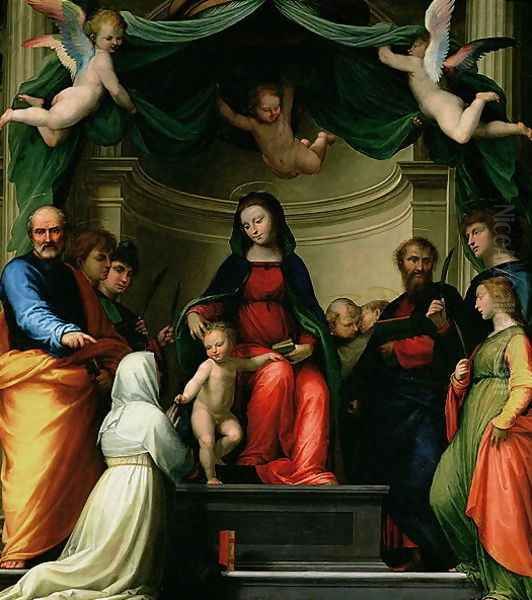
During these formative years, Baccio was exposed to a rich tapestry of artistic influences. The legacy of earlier Florentine masters like Masaccio, with his revolutionary use of perspective and monumental figures, and Fra Angelico, a Dominican friar whose deeply spiritual paintings adorned the walls of the San Marco monastery, was pervasive. More immediately, he would have studied the works of contemporaries such as Filippino Lippi and Piero di Cosimo (who was also associated with Rosselli's workshop). Piero di Cosimo, known for his imaginative and sometimes eccentric mythological scenes, may have imparted an appreciation for nuanced observation and perhaps even an interest in the oil painting techniques being developed by Northern European artists, such as those from Flanders, whose works were increasingly finding their way into Italian collections.
The Profound Impact of Girolamo Savonarola
The late 15th century in Florence was a period of intense political and religious upheaval, largely dominated by the charismatic and controversial Dominican friar, Girolamo Savonarola. Savonarola preached vehemently against the perceived moral corruption of the city, the decadence of the ruling Medici family, and the secularization of art. His fiery sermons captivated many Florentines, including Baccio della Porta.
Baccio became a devout follower of Savonarola, deeply moved by his calls for spiritual renewal and reform. This profound allegiance had a direct and dramatic impact on his artistic output and personal life. In 1496 and 1497, under Savonarola's influence, Florence witnessed the infamous "Bonfires of the Vanities," where citizens were encouraged to burn objects deemed worldly or conducive to sin, including mirrors, fine clothing, books, and artworks considered profane. Tragically, Baccio, in a display of his fervent piety, is said to have consigned some of his own early works, likely those of secular or mythological themes, to the flames.
The political tide eventually turned against Savonarola. He was excommunicated by Pope Alexander VI, arrested, tortured, and in May 1498, hanged and burned in Florence's Piazza della Signoria. The execution of his spiritual mentor was a devastating blow to Baccio. So profound was his grief and spiritual crisis that, in 1500, he made the life-altering decision to abandon his painting career and enter the Dominican Order. He joined the convent of San Domenico in Prato, taking the name Fra Bartolommeo. For approximately four years, he laid down his brushes, dedicating himself entirely to monastic life.
A Friar's Return to Art: The San Marco Workshop
Despite his initial renunciation of painting, Fra Bartolommeo's artistic talent was too significant to remain dormant. Encouraged by his monastic superiors, notably Sante Pagnini, and perhaps recognizing that his art could serve a devotional purpose, he resumed painting around 1504. He was transferred to the Dominican convent of San Marco in Florence, a place already rich in artistic heritage thanks to the extensive fresco cycles painted by Fra Angelico decades earlier. Fra Bartolommeo effectively established a workshop within the monastery, dedicating his renewed artistic practice almost exclusively to religious subjects that reflected his deep faith.
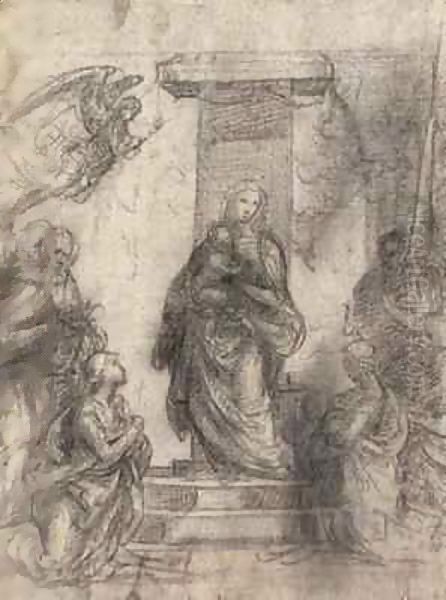
His return to painting coincided with a period of extraordinary artistic ferment in Florence. Leonardo da Vinci had returned to the city around 1500, bringing with him revolutionary ideas about composition, chiaroscuro (the use of strong contrasts between light and dark), and sfumato (the subtle blending of tones to create soft, hazy outlines). The young Raphael Sanzio arrived in Florence in 1504, eager to learn from the Florentine masters. Michelangelo Buonarroti was also a towering presence, his powerful sculptures and paintings setting new standards for anatomical representation and emotional intensity. Fra Bartolommeo was not immune to these powerful currents.
Artistic Style and Technical Innovations
Fra Bartolommeo's mature style is a synthesis of his profound spirituality, his solid Florentine training, and his intelligent absorption of the innovations of his leading contemporaries. His works are characterized by a sense of calm monumentality, balanced and often symmetrical compositions, and a rich, harmonious use of color.
He demonstrated a particular mastery of chiaroscuro, using light and shadow not just to model form but also to create a specific mood, often one of solemnity and divine presence. His figures, typically draped in voluminous, flowing robes, possess a quiet dignity and grace. While his early work showed the clear linearity common in late Quattrocento Florentine painting, his later pieces exhibit softer transitions and a greater sense of atmospheric depth, a clear nod to the influence of Leonardo da Vinci.
Fra Bartolommeo was also attentive to color. His palette became richer and more vibrant over time, possibly influenced by his encounter with Raphael, who was renowned for his harmonious color schemes. There is evidence to suggest that Fra Bartolommeo also traveled to Venice in 1508. If so, exposure to the work of Venetian masters like Giovanni Bellini and Giorgione, celebrated for their mastery of color and light, would have further enriched his own approach. He often employed oil paints, sometimes in combination with tempera, allowing for greater luminosity and depth of tone than traditional tempera alone.
His compositional structures are often grand and architectonic, lending an air of stability and timelessness to his religious scenes. He frequently employed pyramidal compositions, a hallmark of High Renaissance design, to organize groups of figures, creating a sense of visual harmony and focus.
Collaboration with Mariotto Albertinelli
Throughout much of his career, Fra Bartolommeo maintained a close working relationship with Mariotto Albertinelli. Their initial friendship, forged in Rosselli's workshop, evolved into a formal partnership around 1490. They collaborated on several commissions, and their styles, while distinct, were compatible enough for them to work together effectively.
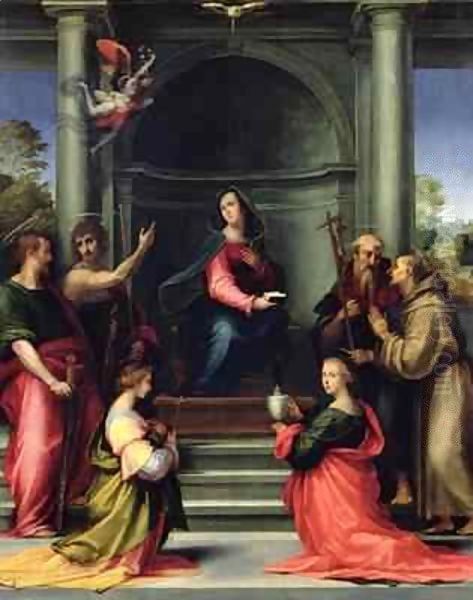
When Fra Bartolommeo entered the Dominican order in 1500 and temporarily ceased painting, Albertinelli continued the workshop. After Fra Bartolommeo resumed painting, their collaboration was renewed, particularly between 1509 and 1512, when they operated a joint workshop. Their works from this period sometimes bear a shared monogram. This partnership was commercially astute, allowing them to undertake larger and more numerous commissions. While Fra Bartolommeo typically focused on the principal figures and the overall design, Albertinelli often contributed to backgrounds, drapery, or secondary figures. However, distinguishing their individual hands in collaborative pieces can sometimes be challenging for art historians.
Key Masterpieces and Their Significance
Fra Bartolommeo produced a significant body of work, primarily large-scale altarpieces and devotional paintings.
One of his earliest important commissions after resuming his career was the Vision of St. Bernard (c. 1504-1507, Accademia, Florence). This work already shows his move towards a more monumental and emotionally resonant style, with a balanced composition and expressive figures.
His Portrait of Girolamo Savonarola (c. 1498, Museo di San Marco, Florence) is a poignant and iconic image. Painted likely from memory or an existing likeness after the friar's death, it captures the intensity and asceticism of his spiritual mentor. The stark profile and dark habit convey Savonarola's formidable presence.
The Last Judgment fresco, originally for the cemetery of the Ospedale di Santa Maria Nuova (fragments now in Museo di San Marco, Florence), was begun by Fra Bartolommeo and Albertinelli around 1499-1501. Fra Bartolommeo designed the upper section with Christ and the saints, showcasing his ability to organize complex multi-figure compositions with clarity and grandeur, even at this relatively early stage of his mature development.
The Mystic Marriage of St. Catherine of Siena (1511, originally for San Marco, now Louvre, Paris, and Accademia, Florence) is a prime example of his High Renaissance style. The composition is majestic and symmetrical, the figures are imbued with a serene dignity, and the colors are rich and harmonious. This work clearly shows the influence of Raphael in its grace and balanced design.
Another significant work is the Salviati Altarpiece or Madonna and Child with Saints (1512, Palazzo Pitti, Florence). This large panel demonstrates his mastery of complex figural arrangements and his ability to convey deep religious sentiment through gesture and expression. The interplay of light and shadow is particularly effective in creating a sense of volume and drama.
His Pala del Gran Consiglio (Madonna and Child with St. Anne and other Saints, 1510-1513, Museo di San Marco, Florence), commissioned for the Sala del Gran Consiglio in the Palazzo Vecchio, was a prestigious undertaking. Though left unfinished in parts, it reveals his ambition in creating monumental compositions comparable to those of Leonardo and Michelangelo for the same hall.
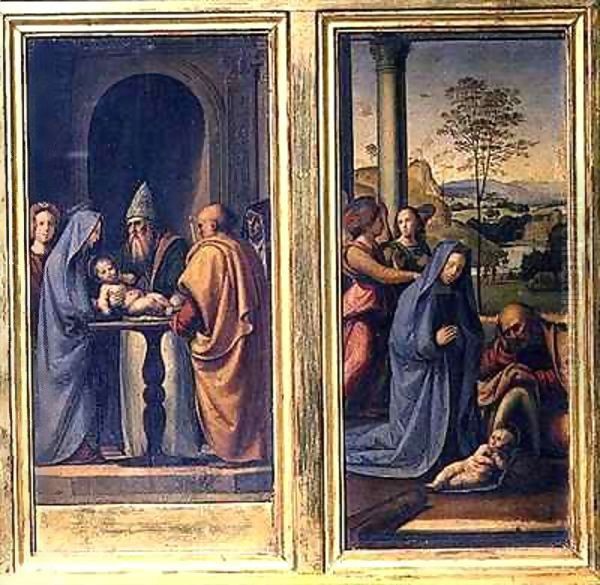
The Annunciation (1497, Volterra Cathedral), an earlier work likely completed with Albertinelli, shows his grounding in the Florentine tradition but already hints at his developing sense of grace and compositional harmony.
Other notable works include:
The Rest on the Flight into Egypt with St. John the Baptist (c. 1509, J. Paul Getty Museum, Los Angeles): A tender and intimate depiction, showcasing his skill in landscape and the gentle interaction between figures.
The Virgin and Child (c. 1500, Galleria Borghese, Rome): An example of his devotional paintings, emphasizing the sacred bond between mother and child.
Numerous drawings, such as The Virgin and Child Researching (1509, Getty), Two Monks' Heads (c. 1511, Getty), and Head of Child, Angel, and Hand (c. 1510-1515, National Gallery of Art, Washington D.C.), reveal his meticulous preparatory process and his skill as a draftsman. These studies often explore variations in pose, gesture, and light before being translated into paint.
Travels and Later Years
Fra Bartolommeo's artistic horizons were broadened by travel. As mentioned, a trip to Venice in 1508 likely exposed him to the rich colorism of Venetian painting, influencing his palette. More significantly, he traveled to Rome in 1514. There, he would have witnessed firsthand the monumental achievements of Michelangelo, particularly the Sistine Chapel ceiling, and the mature works of Raphael, such as the frescoes in the Vatican Stanze.
This Roman sojourn seems to have further encouraged Fra Bartolommeo's inclination towards grandeur and monumentality. His later works, such as the Salvator Mundi (c. 1516, Palazzo Pitti, Florence) and the Assumption of the Virgin (c. 1516, Museo di Capodimonte, Naples), exhibit an increased scale and a more dynamic, almost heroic, quality in the figures, reflecting his engagement with the Roman High Renaissance.
Despite these powerful influences, Fra Bartolommeo's art always retained a distinct character, marked by its inherent sobriety and deep spiritual feeling, which set it apart from the more worldly or classical preoccupations of some of his contemporaries.
Legacy and Influence
Fra Bartolommeo died in Florence on October 31, 1517, at the relatively young age of 45, likely from malaria. Despite his periods of inactivity and his primary dedication to religious life, his impact on Florentine painting was considerable.
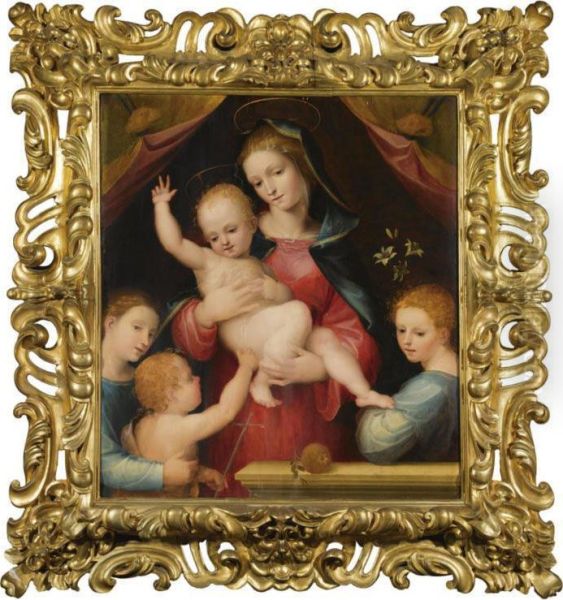
He played a crucial role in disseminating the principles of the High Renaissance style in Florence. His synthesis of Leonardo's sfumato and compositional innovations with Raphael's grace and harmony, all filtered through his own devout sensibility, provided a powerful model for other artists.
He directly influenced Raphael during the latter's Florentine period (1504-1508). Vasari notes that Raphael studied Fra Bartolommeo's handling of color and drapery, while Fra Bartolommeo learned about perspective from the younger Umbrian master. This mutual exchange was beneficial to both.
His workshop at San Marco became an important training ground. Artists like Fra Paolino da Pistoia and, to some extent, Andrea del Sarto, absorbed elements of his style. Andrea del Sarto, often called the "faultless painter," built upon Fra Bartolommeo's use of soft modeling and harmonious color, becoming a leading figure of the Florentine High Renaissance and an early influence on Mannerist painters like Pontormo and Rosso Fiorentino. Even artists who moved towards the more stylized and emotionally charged language of Mannerism, such as Jacopo Pontormo and Rosso Fiorentino, would have been aware of and, in their early careers, responded to the established High Renaissance principles exemplified by Fra Bartolommeo.
His emphasis on clear, balanced compositions and dignified, expressive figures provided a counterpoint to the more agitated or decorative tendencies in some late Quattrocento art. He helped to establish a new standard for religious painting that was both artistically sophisticated and spiritually profound.
In conclusion, Fra Bartolommeo della Porta was more than just a talented painter; he was an artist whose life and work were deeply intertwined with the spiritual currents of his age. His decision to become a friar and his subsequent dedication to religious art lent a unique gravity and sincerity to his paintings. By skillfully integrating the innovations of Leonardo, Raphael, and the Venetian school into his own distinct vision, he created a body of work that stands as a testament to the spiritual depth and artistic brilliance of the Florentine High Renaissance. His legacy endured through his pupils and through the enduring power of his serene and monumental altarpieces.